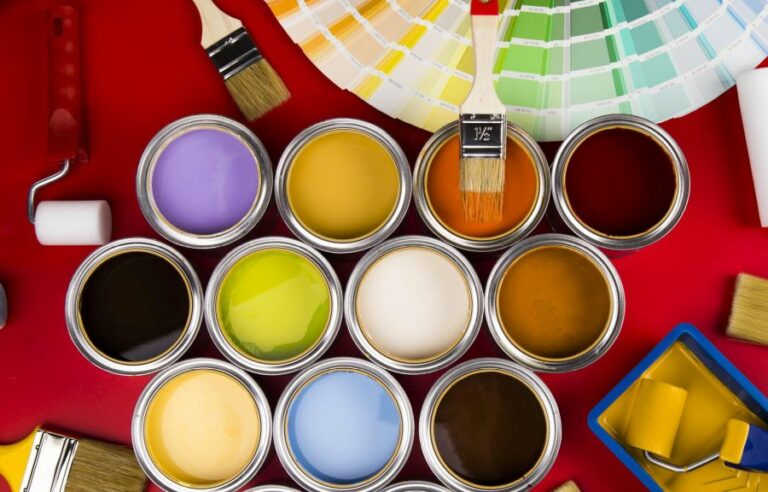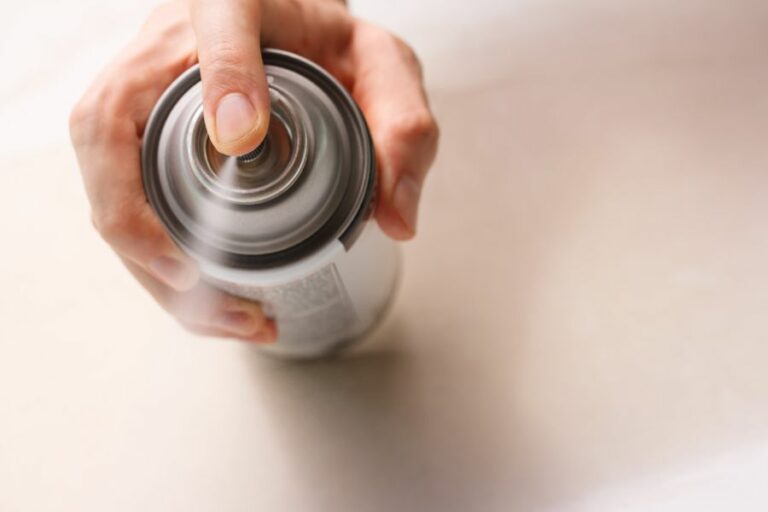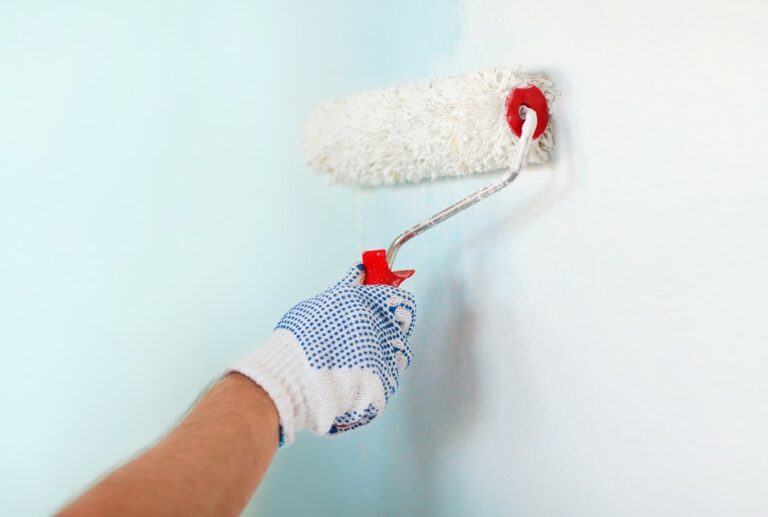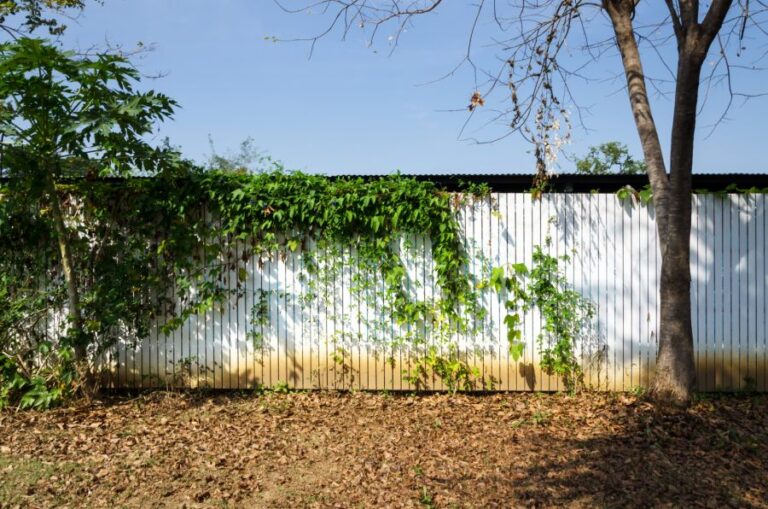Achieve Beautiful Results with These Outdoor Brick Paint Techniques
Welcome to our latest blog post, where we explore the world of outdoor brick paint and its power to transform your exterior spaces. If you’ve been contemplating a makeover for your brick surfaces but aren’t sure where to start, you’ve come to the right place.
We will delve into our detailed guide for choosing the perfect paint, application techniques, and the most sought-after finishes that will refresh and revitalize your home. So step outside, roll up your sleeves, and embark on the journey to breathe new life into your brickwork with splendid results!
Outdoor brick paint:
When painting outdoor brick surfaces, selecting the right paint is crucial for a professional and long-lasting finish. Acrylic latex, elastomeric, and silicate-based mineral paint are recommended options. Prepare the brick surface by cleaning, repairing damage, and removing efflorescence. Use a high-quality masonry primer for even coverage and increased lifespan.
Choose the right tools for application, apply paint in thin coats, and maintain the surface regularly. Considering local weather conditions and the paint manufacturer’s guidelines, this process can transform your property and provide stunning results for years.

Discover the perfect outdoor brick paint for your next project as we explore various types, benefits, and application techniques. Learn which paint goes beyond aesthetics, providing durable protection to enhance and maintain the natural beauty of brick exteriors. Stay tuned for expert recommendations and make an informed choice.
Contents
- 1 Exterior Brick Paint
- 2 What is the Most Suitable Paint for Exterior Brick Surfaces?
- 3 Is it a Good Idea to Paint the Exterior Surface of a Brick Building?
- 4 Is it Possible to Apply Paint Directly onto Exterior Brick Surfaces?
- 5 What Type of Paint is Suitable for Brick Surfaces?
Exterior Brick Paint
• Choosing the Right Brick Paint
Selecting the right paint is crucial for achieving a professional and long-lasting finish when painting your outdoor brick surfaces. Brick paint must be durable, resistant to harsh weather conditions, and breathable to allow moisture to escape from the bricks.
The following are recommended types of paint to use on outdoor brick surfaces:
- Acrylic latex paint: This is the most common paint used for outdoor brick walls, as it is long-lasting, breathable, and offers exceptional resistance against weather and UV rays.
- Elastomeric paint: This type forms a flexible and waterproof membrane on your brick surface, making it ideal for regions with heavy rainfall or humidity. It is also highly durable and offers excellent resistance to fading and cracking.
- Silicate-based mineral paint: This paint is made from mineral pigments and potassium silicate binder that create a strong bond with the brick surface. It is highly breathable, extremely durable, and offers long-lasting color retention.
• Preparing Your Brick Surface for Painting
Before starting the painting process, you must adequately prepare your brick surface. This includes identifying and addressing any potential issues before applying paint:
– Cleaning the Brick Surface
A clean surface ensures the paint bonds effectively with the brick. Use a pressure washer or a brush and soapy water to remove dirt, grime, and debris from the surface of the bricks.
– Repairing Damaged Bricks and Mortar
Inspect the brick surface for damaged or cracked brick and mortar joints. Using a chisel and hammer, carefully replace any damaged mortar with fresh mortar. Allow the new mortar to cure for at least a week before painting.
– Removing Efflorescence
Efflorescence, the white powder that forms on brick surfaces due to the presence of salt, can hinder paint adhesion. Remove efflorescence by scrubbing the surface with a stiff nylon brush and water and white vinegar.
• Priming the Brick Surface
A high-quality primer is essential for achieving an even paint finish and increasing the lifespan of the paint job. When choosing a primer for outdoor brick surfaces, look for products specifically labeled masonry primers due to their superior adhesion and sealing properties.
To prime your brick surface, follow these steps:
- Dilute the primer according to the manufacturer’s instructions.
- Apply the primer using a brush or roller, ensuring even coverage across the entire brick surface.
- Allow the primer to dry for the recommended time before proceeding with the paint application.
• Painting Your Outdoor Brick Surface
Having selected your paint and properly prepared the brick surface, it’s time to begin the painting process:
– Choose the Right Tools
Use a brush, roller, or paint sprayer to apply the paint for the best results. A brush is recommended for small areas, while a roller or sprayer suits larger surfaces. When using a roller, opt for one with a thick nap to ensure proper coverage on the textured brick surface.
– Apply the Paint
Ensure the outdoor temperature is within the paint manufacturer’s recommended range for the application. Apply the paint in thin, even coats, allowing each coat to dry completely before applying the next one.
Most brick surfaces require at least two coats of paint for adequate coverage and durability.
– Clean Up and Maintenance
After completing the painting process, wash your brushes and rollers with soap and water. In the future, regularly inspect your painted brick surface for signs of wear or damage. Repaint areas affected by fading, peeling, or chipping to maintain the overall aesthetic and longevity of the paint job.
• Final Thoughts on Outdoor Brick Paint
Painting outdoor brick surfaces can completely transform the appearance of your property. By choosing the right paint, preparing your brick surface effectively, and following appropriate painting techniques, you can achieve a stunning, professional result that lasts years.
Always consider your local weather conditions and adhere to the paint manufacturer’s guidelines for optimal performance and durability.
What is the Most Suitable Paint for Exterior Brick Surfaces?
• Understanding Exterior Brick Surfaces
Before diving into the different types of paint suitable for outside brick, one must understand the unique characteristics of brick surfaces. Exterior brick is highly porous, absorbing moisture and acting as a natural insulator. It is also highly durable and can last for decades with proper maintenance.
However, its porous nature can also make it challenging to paint, as the paint needs to adhere effectively to the brick while allowing it to breathe.
• Why Use Paint for Exterior Brick?
Prolonged exposure to harsh weather conditions, pollution, and general wear and tear can cause the brick to lose its vibrant color and cause structural damage. Painting your exterior brick can enhance your home’s aesthetics and serve as a protective barrier against environmental elements.
It can also assist in increasing the overall lifespan of your brickwork.
• Factors to Consider When Choosing Paint for Exterior Brick
There are several factors to consider when selecting the best paint for your exterior brick:
- Type of Brick: Some brick surfaces are smoother than others, which may impact the paint you choose. For instance, tumbled brick or historical brick may require different paint types than standard brick.
- Existing Paint or Stain: If your brick already carries a layer of paint or stain, you may need to use compatible products or remove the initial layer before applying new paint.
- Climate and Weather Conditions: When selecting your paint, the local climate and weather patterns should be considered. Some types are better suited to handle extreme temperatures, humidity, or significant temperature fluctuations.
- UV Resistance: Direct sunlight can fade and deteriorate paint. Select a paint that offers UV resistance to keep your exterior looking fresh and vibrant for an extended period.
- Breathability: Exterior brickwork needs to breathe to prevent moisture buildup, which can lead to structural damage. Selecting a paint that allows the brick to breathe while providing a protective barrier is crucial.
• Recommended Paint Options for Exterior Brick
Considering the above factors, the following types of paint are best suited for exterior brick surfaces:
– Acrylic Latex Paint
Acrylic latex paint is one of the most popular options for exterior brick surfaces. This water-based paint offers excellent durability, UV resistance, and breathability. It is also relatively easy to apply and is resistant to peeling and cracking. It provides an attractive finish that is easy to clean and is available in various colors and finishes.
To achieve the best results with acrylic latex paint, it is essential to prime the brick surface using a high-quality masonry primer. Allow the primer ample time to dry before applying two or more thin layers of paint.
– Silicate Paint
Silicate or mineral paint is an excellent choice for exterior brick surfaces due to its high breathability and resistance to weather conditions. This type of paint chemically bonds with the brick, ensuring a long-lasting, protective finish. Silicate paint is also known for its self-cleaning properties, as it easily repels dirt and debris.
Although silicate paint may initially be more costly than acrylic latex paint, it has a significantly longer lifespan and requires less maintenance, making it a worthwhile investment.
– Elastomeric Paint
Elastomeric paint is another suitable option for exterior brick surfaces, as it creates a durable, waterproof barrier that allows the brick to breathe. This type of paint is highly flexible, allowing it to expand and contract with temperature fluctuations without cracking. While elastomeric paint can be more expensive, its resilience and low maintenance make it a cost-effective long-term solution.
One downside to elastomeric paint is that it can be challenging to apply due to its thick consistency. Careful preparation and application are crucial to ensure a smooth, professional finish.
• Final Thoughts
In conclusion, the best paint for outside brick should offer durability, breathability, and protection against environmental elements. Acrylic latex, silicate, and elastomeric paint all fit these criteria, each offering unique benefits depending on your specific needs and budget.
Regardless of the paint type, proper surface preparation and application are crucial to ensure a long-lasting and attractive finish for your exterior brick surfaces.
Paint Type | Features | Benefits |
|---|---|---|
Acrylic Latex Paint | Water-based, durable, good adhesion | Long-lasting, easy to clean, dries quickly |
Elastomeric Paint | Thick, flexible, waterproof | Helps prevent moisture buildup, is long-lasting, great for older bricks |
Silicate Paint | Mineral-based, breathable | Helps prevent moisture buildup, long-lasting, great for older bricks |
Lime Wash | Mineral-based, natural, breathable | Gives a unique textured appearance, excellent vapor permeability |
Is it a Good Idea to Paint the Exterior Surface of a Brick Building?
The Expert Guide to Painting Exterior Brick Houses for a Fresh Look and Long-lasting Protection
• Introduction
Painting exterior brick is a popular trend among homeowners looking to update their home’s appearance and increase curb appeal. However, many people wonder if it’s a good idea or if it’s just a temporary fix that will lead to more problems down the line. The truth is that painting exterior brick can be beneficial and problematic, depending on the condition of the brick and the techniques used during the process.
We will explore the pros and cons of painting exterior brick, the various paint options available, techniques for a professional finish, and the importance of proper brick care and maintenance. In the end, you’ll be able to make an informed decision on whether or not painting your brick home is right for you.
• Understanding the Benefits of Painting Exterior Brick
There are several advantages to painting exterior brick, which may make it an appealing option for homeowners. These benefits include:
– Improved Aesthetics
One of the primary reasons homeowners choose to paint their brick homes is to improve their overall appearance. This can be particularly beneficial if the brick is outdated, stained, and discolored from age and exposure to the elements. Painting the brick can provide a fresh, modern look that enhances your home’s curb appeal.
– Increased Protection
Applying high-quality paint to the exterior brick can provide additional protection from the elements. Paint can help to seal small cracks and gaps in the mortar, reducing the risk of water penetration and potential damage.
This can be particularly useful in areas with harsh weather conditions, where brick homes may be more susceptible to damage.
– Energy Efficiency
A lesser-known benefit of painting exterior brick is the potential for improved energy efficiency. Light-colored paint can reflect sunlight, helping to keep your home cooler during the hot summer months. This can reduce air conditioning costs, making it an environmentally friendly and cost-effective option.
• Potential Drawbacks of Painting Exterior Brick
While there are numerous advantages to painting exterior brick, it’s also essential to consider the potential negatives before deciding.
– Maintenance and Longevity
Unlike natural brick, painted brick requires regular maintenance to keep it looking its best. Over time, paint can chip, crack, and fade, meaning your home will require periodic touch-ups or repainting.
Additionally, if the paint is not properly applied or the brick surface is not adequately prepared, the paint may deteriorate more quickly and require more frequent maintenance.
– Resale Value
Some potential homebuyers may view painted brick as a negative due to the maintenance requirements and the perception that it is not authentic. This could impact your home’s resale value if you choose to sell.
– Moisture Issues
If the brick and mortar are in poor condition or the paint job is not done correctly, painted brick can lead to moisture issues. Trapped moisture can lead to mold, mildew, and structural damage. It’s crucial to address any underlying issues with the brick before painting and ensure the paint is applied correctly.
• Selecting the Right Paint for Your Brick Home
Not all paint is suitable for exterior brick, so choosing a product specifically designed for this purpose is essential. Opt for a high-quality, water-resistant acrylic or masonry paint that allows the brick to breathe while providing adequate protection.
It’s also crucial to select a primer specifically designed for use with brick surfaces. Proper primer will help the paint adhere better, improve longevity, and promote a smooth finish.
• Professional Techniques for Painting Exterior Brick
For the best results, it’s recommended to seek the assistance of a professional painting contractor experienced in working with brick. However, if you choose to tackle the project yourself, take the following steps to ensure a successful paint job:
- Inspect and Repair: Thoroughly examine the brick surface for any damage or areas needing repair, such as cracked or missing mortar. Make necessary repairs and allow sufficient time to cure before the painting begins.
- Thoroughly Clean the Brick: Remove dirt, debris, and any loose paint or mortar using a wire brush, followed by pressure washing the surface. Allow the brick to dry completely before applying any paint.
- Apply Primer: Using a quality brick primer, apply using a brush, roller, or sprayer, working the primer into the brick’s texture. Cover the surface evenly and allow the primer to dry according to the manufacturer’s recommended time.
- Apply the Paint: After drying the primer, apply high-quality masonry or acrylic paint using a brush, roller, or sprayer. Apply multiple thin, even coats, allowing sufficient drying time between each coat.
- Regular Maintenance: Check the painted brick periodically and address any signs of peeling, chipping, or cracking paint as soon as possible to prevent more extensive damage.
• Final Thoughts
In conclusion, painting exterior brick can be a good idea in certain circumstances. It can provide a fresh, modern look, increased protection, and improved energy efficiency. However, it’s crucial to consider the potential drawbacks, such as the maintenance requirements, resale value, and moisture issues.
Always use high-quality products designed specifically for brick surfaces to ensure the best results, and consider hiring a professional for optimal results. With careful planning and execution, painting your brick home can be a wise investment in your home’s appearance and longevity.
Is it Possible to Apply Paint Directly onto Exterior Brick Surfaces?
Brick exteriors have always been in style due to their durability, low maintenance, and timeless appearance. However, there may come a time when you want to give your brick exterior a new look or update it to match your home’s overall design. Painting brick is a popular option, but knowing the right process and products are essential to achieve the best results.
We will guide you through the steps to paint straight onto exterior brick, including preparation, choosing the right paint, and crucial tips to ensure an enduring finish.
• Preparing the Brick Surface for Painting
– Cleaning the Brick
Before you begin painting, it’s crucial to ensure the brick surface is clean and free of dirt, dust, and debris. Depending on the level of grime, you may opt for one of the following methods:
- Mild cleaning: Use a bristle brush and warm soapy water to remove dirt and dust from your brick exterior. Rinse with a hose and let the brick dry before moving forward.
- Deep cleaning: For stubborn stains, algae, and mold, use a pressure washer to remove them entirely. Keeping the pressure washer’s tip at least 10 inches from the surface is essential to avoid damaging the brick.
– Repairing the Mortar
Inspect the mortar between the bricks for any damaged, cracked, or missing sections. Repairing the mortar is essential to ensure a smooth and even finish when applying paint. The process of repairing mortar is called repointing and involves the following steps:
- Remove damaged mortar using a chisel or grinder.
- Mix new mortar, following the manufacturer’s instructions on the package.
- Apply the new mortar using a trowel to fill in all gaps.
- Let the mortar cure for the recommended time, usually around three days.
– Sealing the Brick
Applying a sealer or primer is essential for a long-lasting paint finish on exterior brick. Select a high-quality primer that is specifically designed for masonry surfaces. A dedicated masonry primer will ensure proper bonding between the brick and paint, increasing durability and promoting an even application.
Following the manufacturer’s directions, apply a single coat of the chosen primer to the entire surface and allow it to dry thoroughly.
• Choosing the Right Paint
Utilizing the right type of paint is critical when painting exterior brick. To ensure a long-lasting finish, select an exterior-grade paint that is breathable, specifically designed for masonry surfaces, and is resistant to weather conditions.
- Acrylic Latex paint: Acrylic latex paint is the most recommended option for exterior brick due to its exceptional breathability, flexibility, and durability. It also provides excellent resistance to mildew and UV light and easy cleanup with soap and water.
- Elastomeric paint is another suitable option for brick surfaces, providing more waterproofing and flexibility. However, elastomeric paint tends to be more expensive and might require professional application to achieve the desired results.
• Painting the Brick Exterior
Once your brick surface is primed and ready, it’s time to begin painting. Follow these steps for a smooth paint application process:
- Choose the right tools: Consider using a combination of paintbrushes and rollers for a seamless finish. Opt for brushes with sturdy bristles and a roller with a long nap for optimal coverage on the textured brick surface.
- Paint from top to bottom: Start painting the top portion of your brick exterior and work your way down to prevent dripping.
- Use thin, even coats: Applying thin coats ensures an even color distribution and proper paint bonding. This is particularly important when working with exterior surfaces.
- Apply multiple coats: Depending on the paint, you may require two to three coats to achieve the desired coverage and finish. Always allow each coat to dry thoroughly before applying the next.
• Crucial Tips for Painting Exterior Brick
To ensure the best possible results, consider the following tips when painting your brick exterior:
- Avoid painting on wet or damp surfaces, as this can lead to paint peeling or bubbling over time.
- Plan your painting project during a time of mild, dry weather. Painting in extreme temperatures or high humidity can negatively impact the paint’s adhesion and drying process.
- Keep painted brick surfaces well-maintained by periodically checking for cracks, chips, or fading. Promptly repair any damage to ensure the longevity of your paint job.
In conclusion, painting straight onto exterior brick is achievable for homeowners looking to update their home’s appearance. By adequately preparing the surface, selecting the right paint, and following expert tips, you can transform your brick exterior with a fresh, vibrant look that will last for years.
Question | Answer |
|---|---|
Can you paint straight onto the exterior brick? | Yes, but cleaning and preparing the surface before painting is important. Ensure the brick is free from dirt, dust, and mold, and use a suitable masonry primer before applying the paint. |
What Type of Paint is Suitable for Brick Surfaces?
Brick is a beautiful and timeless building material used in construction for centuries. It offers homeowners and building owners a sturdy and durable option but may require some maintenance or aesthetic intervention. One of the ways to enhance the appearance of brick or protect the surface is by painting it.
We will discuss the different types of paint to use on brick surfaces and how they can benefit your residential or commercial property.
• Understanding Brick as a Substrate
Before delving into the best paint options for brick, it’s important to understand some of the fundamental characteristics of brick as a building material. Brick is porous, meaning it absorbs water and can be subject to efflorescence, a white crystalline deposit that forms on the brick surface when water evaporates.
This is important when selecting a paint option because you need to choose one that will adhere to the brick and resist moisture and efflorescence.
• Exterior vs. Interior Brick Painting
It’s important to distinguish whether your project involves painting brick on the exterior or interior of your property, as this will impact your choice of paint.
– Exterior Brick Painting
For exterior brick surfaces, you need to choose durable and weather-resistant paint that can withstand moisture and UV rays, temperature fluctuations, and wear and tear from the outdoor environment.
Acrylic Latex Paint
Acrylic latex paint is one of the most popular choices for exterior brick surfaces. This type of paint is water-based, more environmentally friendly, and easier to clean up than oil-based paints. It offers excellent adhesion, durability, and color retention, making it an ideal choice for painting brick.
I recommend using high-quality acrylic latex paint with a flat or satin finish for exterior brick surfaces. A flat finish is ideal for more uniform color and reduced glare, while a satin finish offers a slight sheen and is easier to clean.
Elastomeric Paint
Elastomeric paint is another great option for exterior brick surfaces because of its water-resistant properties. This type of paint is designed to expand and contract with the surface it is applied to, allowing it to bridge small cracks, providing a water-resistant barrier, and reducing the risk of efflorescence.
I recommend using elastomeric paint on exterior brick surfaces prone to moisture issues, such as walls near the ground or areas subject to splashback from nearby surfaces.
– Interior Brick Painting
You can opt for a more decorative finish for interior brick surfaces, as there is typically less concern about exposure to the elements and potential moisture issues.
Acrylic and Acrylic Latex Paint
Much like in the case of exterior brick painting, acrylic and acrylic latex paints are suitable choices for interior applications. These water-based paints offer good adhesion, color retention, and a broad range of finish options, from flat to glossy.
I recommend using acrylic or acrylic latex paint with a satin or semi-gloss finish for interior brick surfaces. These finishes offer a balance between a subtle sheen and ease of cleaning.
Lime Paint
Lime paint is a more traditional and eco-friendly option for interior brick painting. Lime paint is made from natural slaked lime and pigments, providing a mineral matte finish that allows the brick to breathe.
This is beneficial in preventing moisture buildup and efflorescence, especially in older homes or historical buildings with brick interiors.
I recommend using lime paint in historic restoration projects or for those seeking a more traditional, European-style aesthetic.
• Preparing Brick for Painting
Before painting brick, it’s important to properly prepare the surface to ensure a long-lasting and quality finish. Begin by cleaning the brick surface of any dirt, dust, and debris using a wire brush, followed by thorough rinsing with water.
Allow the surface to dry completely before applying any paint, as a moisture-laden brick can lead to peeling, bubbling, or other paint failures.
In instances where efflorescence is present, use a masonry cleaner specifically designed to remove these mineral deposits and rinse the surface thoroughly with water.
Lastly, apply a masonry primer to the brick, which serves as a foundation to enhance paint adhesion and provide more even color and finish.
• Conclusion
In summary, the best paint to use on brick surfaces, both inside and outside, relies heavily on the specific needs of your project, such as durability, water resistance, and aesthetic finish. Acrylic latex paint and elastomeric paint are highly recommended for exterior brick surfaces, while acrylic, acrylic latex, and lime paints are suitable options for interior brick painting.
Remember to properly prepare your brick surface before applying any paint, and enjoy the renewed beauty and protection offered by a fresh coat of paint on your brick property.
Type of Paint | Description |
|---|---|
Masonry Paint | Specifically designed for use on brick, concrete, and other masonry surfaces. Provides a durable, weather-resistant finish. |
Acrylic Latex Paint | Water-based paint that adheres well to brick and provides a long-lasting finish. Easier to clean up than oil-based paints. |
Mineral-based Silicate Paint | Provides excellent breathability and allows moisture to escape the brick. Highly durable and resistant to weather conditions. |
Lime Wash | Offers a unique, aged look while allowing the brick to breathe. Can be applied in multiple layers for the desired effect. |







